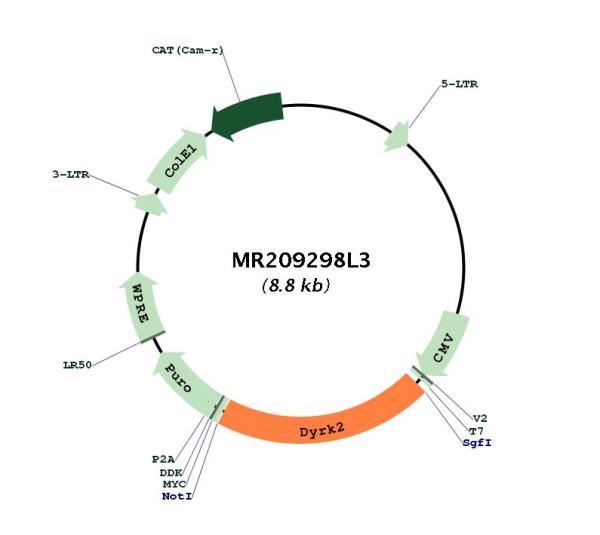Dyrk2 (NM_001014390) Mouse Tagged Lenti ORF Clone
CAT#: MR209298L3
- LentiORF®
Lenti ORF clone of Dyrk2 (Myc-DDK-tagged) - Mouse dual-specificity tyrosine-(Y)-phosphorylation regulated kinase 2 (Dyrk2)
"NM_001014390" in other vectors (6)
Interest in protein/lysate? Submit request here!
Specifications
| Product Data | |
| Type | Mouse Tagged ORF Clone |
| Tag | Myc-DDK |
| Symbol | Dyrk2 |
| Synonyms | 1810038L18Rik |
| Vector | pLenti-C-Myc-DDK-P2A-Puro |
| E. coli Selection | Chloramphenicol (34 ug/mL) |
| Mammalian Cell Selection | Puromycin |
| Sequence Data |
The ORF insert of this clone is exactly the same as(MR209298).
|
| Restriction Sites |
SgfI-NotI
Cloning Scheme for this gene
Plasmid Map

|
| ACCN | NM_001014390 |
| ORF Size | 1797 bp |
| OTI Disclaimer | Due to the inherent nature of this plasmid, standard methods to replicate additional amounts of DNA in E. coli are highly likely to result in mutations and/or rearrangements. Therefore, OriGene does not guarantee the capability to replicate this plasmid DNA. Additional amounts of DNA can be purchased from OriGene with batch-specific, full-sequence verification at a reduced cost. Please contact our customer care team at custsupport@origene.com or by calling 301.340.3188 option 3 for pricing and delivery. The molecular sequence of this clone aligns with the gene accession number as a point of reference only. However, individual transcript sequences of the same gene can differ through naturally occurring variations (e.g. polymorphisms), each with its own valid existence. This clone is substantially in agreement with the reference, but a complete review of all prevailing variants is recommended prior to use. More info |
| OTI Annotation | This clone was engineered to express the complete ORF with an expression tag. Expression varies depending on the nature of the gene. |
| Product Components | The ORF clone is ion-exchange column purified and shipped in a 2D barcoded Matrix tube containing 10ug of transfection-ready, dried plasmid DNA (reconstitute with 100 ul of water). |
| Reconstitution | 1. Centrifuge at 5,000xg for 5min. 2. Carefully open the tube and add 100ul of sterile water to dissolve the DNA. 3. Close the tube and incubate for 10 minutes at room temperature. 4. Briefly vortex the tube and then do a quick spin (less than 5000xg) to concentrate the liquid at the bottom. 5. Store the suspended plasmid at -20°C. The DNA is stable for at least one year from date of shipping when stored at -20°C. |
| Reference Data | |
| RefSeq | NM_001014390.2, NP_001014412.1 |
| RefSeq Size | 2137 bp |
| RefSeq ORF | 1800 bp |
| Locus ID | 69181 |
| UniProt ID | Q5U4C9 |
| Cytogenetics | 10 D2 |
| Gene Summary | Serine/threonine-protein kinase involved in the regulation of the mitotic cell cycle, cell proliferation, apoptosis, organization of the cytoskeleton and neurite outgrowth. Functions in part via its role in ubiquitin-dependent proteasomal protein degradation. Functions downstream of ATM and phosphorylates p53/TP53 at 'Ser-46', and thereby contributes to the induction of apoptosis in response to DNA damage. Phosphorylates NFATC1, and thereby inhibits its accumulation in the nucleus and its transcription factor activity. Phosphorylates EIF2B5 at 'Ser-544', enabling its subsequent phosphorylation and inhibition by GSK3B. Likewise, phosphorylation of NFATC1, CRMP2/DPYSL2 and CRMP4/DPYSL3 promotes their subsequent phosphorylation by GSK3B. May play a general role in the priming of GSK3 substrates. Inactivates GYS1 by phosphorylation at 'Ser-641', and potentially also a second phosphorylation site, thus regulating glycogen synthesis. Mediates EDVP E3 ligase complex formation and is required for the phosphorylation and subsequent degradation of KATNA1. Phosphorylates TERT at 'Ser-457', promoting TERT ubiquitination by the EDVP complex. Phosphorylates SIAH2, and thereby increases its ubiquitin ligase activity. Promotes the proteasomal degradation of MYC and JUN, and thereby regulates progress through the mitotic cell cycle and cell proliferation. Promotes proteasomal degradation of GLI2 and GLI3, and thereby plays a role in smoothened and sonic hedgehog signaling. Phosphorylates CRMP2/DPYSL2, CRMP4/DPYSL3, DCX, EIF2B5, EIF4EBP1, GLI2, GLI3, GYS1, JUN, MDM2, MYC, NFATC1, p53/TP53, TAU/MAPT and KATNA1. Can phosphorylate histone H1, histone H3 and histone H2B (in vitro). Can phosphorylate CARHSP1 (in vitro) (By similarity). Plays a role in cytoskeleton organization and neurite outgrowth via its phosphorylation of DCX.[UniProtKB/Swiss-Prot Function] |
Documents
| Product Manuals |
| FAQs |
| SDS |
Resources
Other Versions
| SKU | Description | Size | Price |
|---|---|---|---|
| MC202604 | Dyrk2 (untagged) - Mouse dual-specificity tyrosine-(Y)-phosphorylation regulated kinase 2 (Dyrk2), (10ug) |
USD 837.00 |
|
| MG209298 | Dyrk2 (tGFP-tagged) - Mouse dual-specificity tyrosine-(Y)-phosphorylation regulated kinase 2 (Dyrk2) |
USD 1,092.00 |
|
| MR209298 | Dyrk2 (Myc-DDK-tagged) - Mouse dual-specificity tyrosine-(Y)-phosphorylation regulated kinase 2 (Dyrk2) |
USD 892.00 |
|
| MR209298L1 | Lenti ORF clone of Dyrk2 (Myc-DDK-tagged) - Mouse dual-specificity tyrosine-(Y)-phosphorylation regulated kinase 2 (Dyrk2) |
USD 1,192.00 |
|
| MR209298L2 | Lenti ORF clone of Dyrk2 (mGFP-tagged) - Mouse dual-specificity tyrosine-(Y)-phosphorylation regulated kinase 2 (Dyrk2) |
USD 1,192.00 |
|
| MR209298L4 | Lenti ORF clone of Dyrk2 (mGFP-tagged) - Mouse dual-specificity tyrosine-(Y)-phosphorylation regulated kinase 2 (Dyrk2) |
USD 1,192.00 |
{0} Product Review(s)
Be the first one to submit a review






























































































































































































































































 Germany
Germany
 Japan
Japan
 United Kingdom
United Kingdom
 China
China


